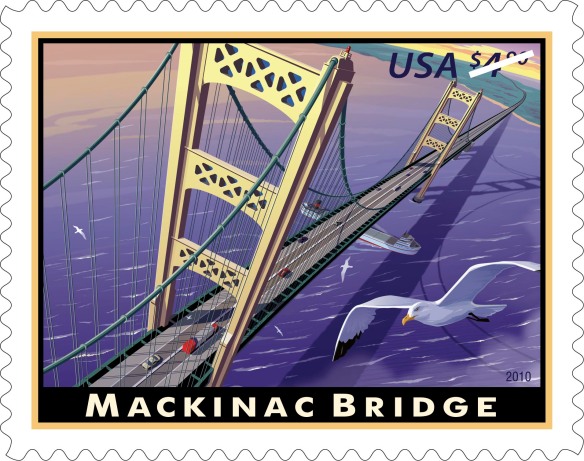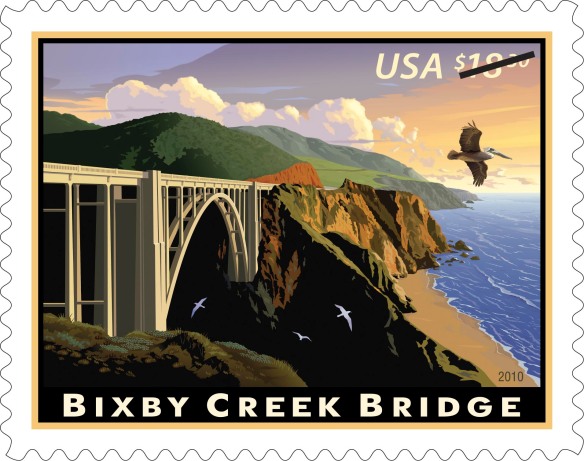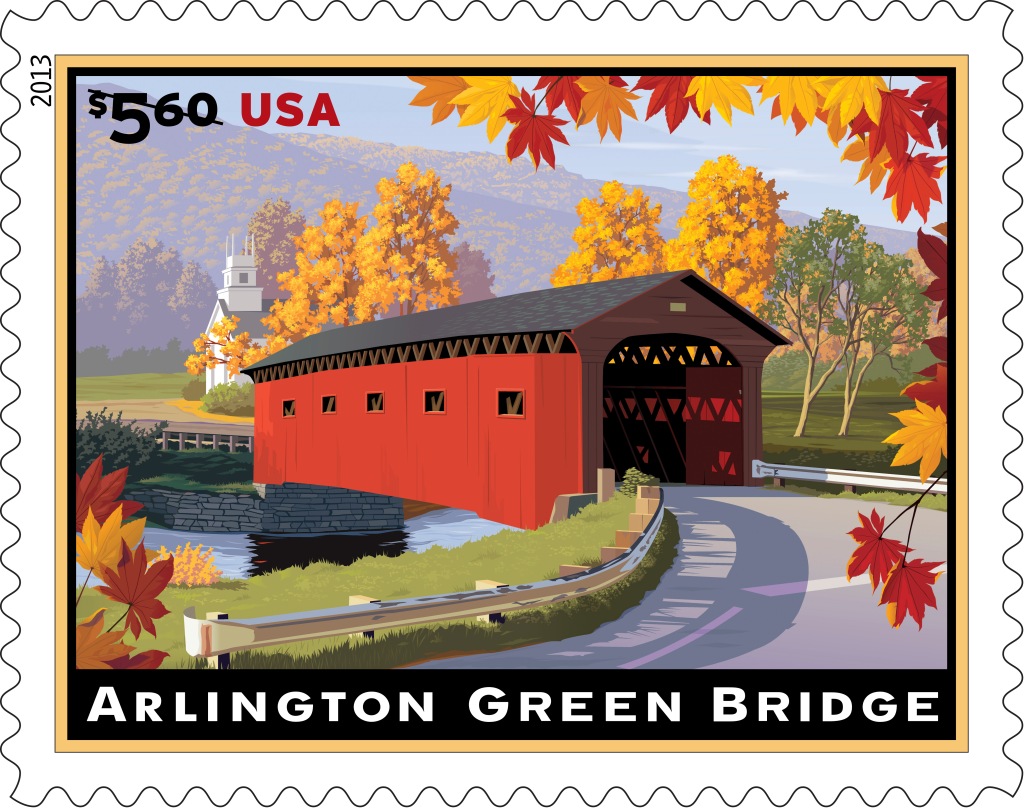On May 24, 1883, the New York and Brooklyn Bridge, as it was known then, was opened for use, connecting the boroughs of Manhattan and Brooklyn by spanning the East River. Later renamed the Brooklyn Bridge, the iconic structure is one if the oldest suspension bridges in the United States.
In honor of this historic landmark, here are some other great American bridges that have appeared on postage stamps.
 Spanning the Niagara River between Buffalo, New York, and Fort Eerie, Ontario, the Peace Bridge was officially dedicated on August 7, 1927. The 3,580-foot steel bridge carries $40 billion in international trade each year. This stamp was issued in 1977 to commemorate the bridge’s 50th anniversary.
Spanning the Niagara River between Buffalo, New York, and Fort Eerie, Ontario, the Peace Bridge was officially dedicated on August 7, 1927. The 3,580-foot steel bridge carries $40 billion in international trade each year. This stamp was issued in 1977 to commemorate the bridge’s 50th anniversary.
 The longest covered bridge in America until 2008, the landmark Cornish-Windsor Bridge accommodates two-way vehicular traffic between the towns of Cornish, New Hampshire, and Windsor, Vermont. Measuring about 450 feet long, it was constructed in 1866, at a cost of $9,000, and was a toll bridge until 1943.
The longest covered bridge in America until 2008, the landmark Cornish-Windsor Bridge accommodates two-way vehicular traffic between the towns of Cornish, New Hampshire, and Windsor, Vermont. Measuring about 450 feet long, it was constructed in 1866, at a cost of $9,000, and was a toll bridge until 1943.
 The double-decked San Francisco – Oakland Bay Bridge is an iconic structure in the San Francisco skyline. The most direct access between San Francisco and Oakland in California, the 1936 bridge is composed of three parts—a cantilever portion on the eastern span, a suspension portion on the western span, and a tunnel through Yerba Buena Island halfway across the San Francisco Bay.
The double-decked San Francisco – Oakland Bay Bridge is an iconic structure in the San Francisco skyline. The most direct access between San Francisco and Oakland in California, the 1936 bridge is composed of three parts—a cantilever portion on the eastern span, a suspension portion on the western span, and a tunnel through Yerba Buena Island halfway across the San Francisco Bay.

The Mackinac Bridge, nicknamed “Mighty Mac,” connects the two peninsulas of Michigan across the Straits of Mackinac. Spanning a total of 26,372 feet, this bridge is the longest suspension bridge in the Western Hemisphere.
 The Verrazano-Narrows Bridge, connecting Brooklyn and Staten Island in New York, is named after Giovanni da Verrazano, a European explorer who sailed into the area in 1524. Two towers, each 693 feet tall, stand 4,260 feet apart; the bridge’s total length is 13,700 feet.
The Verrazano-Narrows Bridge, connecting Brooklyn and Staten Island in New York, is named after Giovanni da Verrazano, a European explorer who sailed into the area in 1524. Two towers, each 693 feet tall, stand 4,260 feet apart; the bridge’s total length is 13,700 feet.
 The Bixby Creek Bridge was one of the seven classic concrete-arch bridges that eased the way for recreational and commercial travel in California along the Big Sur coast by way of the Carmel-San Simeon Highway, now known as State Highway Route 1. Dedicated in 1932, the Bixby Creek Bridge was named after Charlie Bixby, an early settler in the area.
The Bixby Creek Bridge was one of the seven classic concrete-arch bridges that eased the way for recreational and commercial travel in California along the Big Sur coast by way of the Carmel-San Simeon Highway, now known as State Highway Route 1. Dedicated in 1932, the Bixby Creek Bridge was named after Charlie Bixby, an early settler in the area.
 One of the highest bridges in the United States, the New River Gorge Bridge in Fayette County, West Virginia, features a 1,700-foot span that is the longest steel arch in the Western Hemisphere. The Washington Monument could fit under its 876-foot arch with more than 300 feet to spare.
One of the highest bridges in the United States, the New River Gorge Bridge in Fayette County, West Virginia, features a 1,700-foot span that is the longest steel arch in the Western Hemisphere. The Washington Monument could fit under its 876-foot arch with more than 300 feet to spare.

After more than four years of construction, the Golden Gate Bridge opened to vehicular traffic on May 28, 1937. Boasting a 4,200-foot-long main span, the “International Orange” bridge carried the moderate price tag of $35,000,000.
 The Sunshine Skyway Bridge in Florida was one of the first major concrete-and-steel, cable-stayed bridges in the United States. Completed in 1987, the main bridge and approach spans stretch more than four miles across Tampa Bay and link the Gulf Coast communities surrounding St. Petersburg and Bradenton. Engineers designed the cable-stayed section of the bridge to soar 190 feet above the water to allow unhindered navigation to and from the busy port of Tampa.
The Sunshine Skyway Bridge in Florida was one of the first major concrete-and-steel, cable-stayed bridges in the United States. Completed in 1987, the main bridge and approach spans stretch more than four miles across Tampa Bay and link the Gulf Coast communities surrounding St. Petersburg and Bradenton. Engineers designed the cable-stayed section of the bridge to soar 190 feet above the water to allow unhindered navigation to and from the busy port of Tampa.
 The 1,500-foot Eads Bridge, spanning the Mississippi River in St. Louis, Missouri, was completed in 1874. The hustle and bustle of steamboats chugging along the river and streetcars and carriages crossing the bridge in the stamp art portrays the importance of structures like the Eads Bridge in westward expansion and the Industrial Revolution.
The 1,500-foot Eads Bridge, spanning the Mississippi River in St. Louis, Missouri, was completed in 1874. The hustle and bustle of steamboats chugging along the river and streetcars and carriages crossing the bridge in the stamp art portrays the importance of structures like the Eads Bridge in westward expansion and the Industrial Revolution.
Bridges are truly fascinating feats of engineering. The ability to span bodies of water helped connect American commerce and travel in significant ways throughout our history. Most bridges provide stunning views of nearby scenery, too. Which is your favorite?












